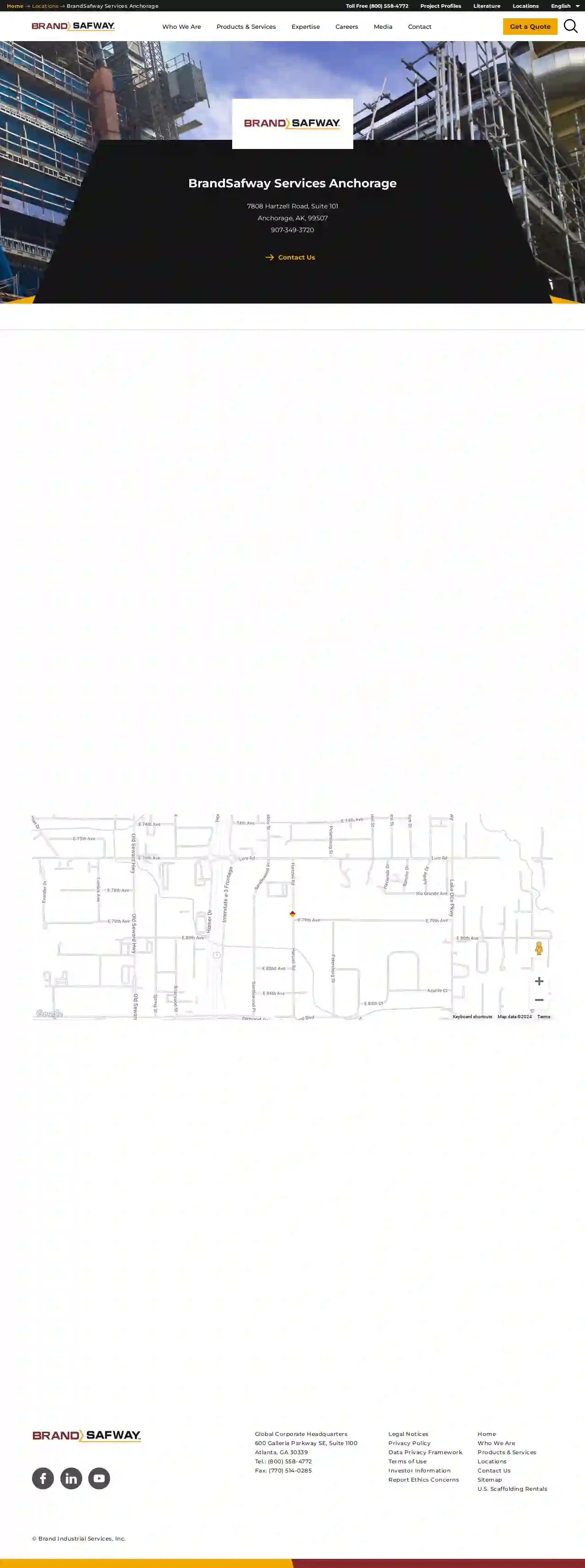Scaffolding Companies Kalifornsky
Best Scaffolding Builders in Kalifornsky
Get 3 FREE Scaffolding Builders quotes for your project today! Compare profiles, reviews, accreditations, portfolio, etc... and choose the best offer.

BrandSafway Services Anchorage
3.77 reviews1000 W 3rd Ave, Suite 100, 1000 W 3rd Ave Suite 100, Anchorage, 99501, USBrandsafway is a leading provider of comprehensive safety training and consulting services in Anchorage, Alaska. With a proven track record of success, we are dedicated to helping businesses of all sizes create a safer and more productive work environment. Our team of experienced safety professionals offers a wide range of services, including OSHA compliance training, hazard identification and control, safety program development, and emergency response planning. We are committed to providing our clients with the highest quality training and consulting services, tailored to their specific needs and industry requirements. At Brandsafway, we believe that safety is everyone's responsibility, and we are passionate about helping our clients achieve their safety goals.
- Services
- Why Us?
Get Quote- Th
The Home Depot
4.1548 reviewsAnchorage, US- Services
- Why Us?
Get Quote - Sp
Spenard Builders Supply
4.280 reviewsAnchorage, US- Services
- Why Us?
Get Quote - Ar
Arrowhead Scaffold
4.511 reviewsAnchorage, US- Services
- Why Us?
Get Quote - Lo
Lowe's Home Improvement
4.1900 reviewsAnchorage, US- Services
- Why Us?
Get Quote - Lo
Lowe's Home Improvement
4.1994 reviewsAnchorage, US- Services
- Why Us?
Get Quote - Th
The Home Depot
4962 reviewsAnchorage, US- Services
- Why Us?
Get Quote - Eq
Equipment Source Inc
3.819 reviewsAnchorage, US- Services
- Why Us?
Get Quote - Th
The Home Depot
3.9722 reviewsAnchorage, US- Services
- Why Us?
Get Quote - Th
The Home Depot
4.1827 reviewsAnchorage, US- Services
- Why Us?
Get Quote
Over 2,353+ Scaffolding Businesses registered
Our scaffolding contractors operate in Kalifornsky and beyond!
ScaffoldingHQ has curated and vetted the Best Scaffolding Companies in and around Kalifornsky. Find a top & reliable contractor today.
Frequently Asked Questions About Scaffolding Companies
- Tube and Clamp Scaffolding: A traditional and versatile system using individual tubes and clamps. It's highly adaptable but requires more time to erect.
- System Scaffolding: Pre-engineered systems with modular components that fit together quickly. They offer speed and efficiency, especially for larger projects.
- Suspended Scaffolding: Hung from a roof or overhead structure, ideal for high-rise buildings or areas with limited ground access.
- Mobile Scaffolding: Mounted on wheels, allowing easy movement around a worksite. Suitable for tasks like painting or plastering.
- Specialized Scaffolding: Cantilever scaffolding, rolling towers, and other specialized systems cater to specific needs.
- Work at Height Regulations 2005: Covers all work at height and outlines the need for risk assessments, competent erectors, and safe equipment.
- Construction (Design and Management) Regulations 2015 (CDM): Applies to construction projects and requires planning for scaffolding safety throughout the project lifecycle.
- British Standard BS EN 12811: Sets standards for the design, manufacture, and testing of scaffolding components.
- NASC (National Access & Scaffolding Confederation) Guidance: Provides industry best practices and safety recommendations for scaffolding.
- Regulations: Local regulations often specify minimum inspection intervals.
- Project Type and Duration: Long-term projects or those in challenging environments may require more frequent inspections.
- Weather Conditions: Severe weather (storms, high winds) can necessitate additional inspections.
- Any Alterations or Modifications: Any changes to the scaffolding structure require re-inspection.
- Encroaches onto public property (sidewalks, roads): Permits are usually needed from the local council or highway authority.
- Exceeds a certain height: Scaffolding above a specified height often requires a permit.
- Is erected in a conservation area or near a listed building: Special considerations and permits may apply.
What are the different types of scaffolding?
What are the safety regulations for scaffolding in the USA?
How often should scaffolding be inspected?
Do I need a permit for scaffolding in the USA?
What are the different types of scaffolding?
- Tube and Clamp Scaffolding: A traditional and versatile system using individual tubes and clamps. It's highly adaptable but requires more time to erect.
- System Scaffolding: Pre-engineered systems with modular components that fit together quickly. They offer speed and efficiency, especially for larger projects.
- Suspended Scaffolding: Hung from a roof or overhead structure, ideal for high-rise buildings or areas with limited ground access.
- Mobile Scaffolding: Mounted on wheels, allowing easy movement around a worksite. Suitable for tasks like painting or plastering.
- Specialized Scaffolding: Cantilever scaffolding, rolling towers, and other specialized systems cater to specific needs.
What are the safety regulations for scaffolding in the USA?
- Work at Height Regulations 2005: Covers all work at height and outlines the need for risk assessments, competent erectors, and safe equipment.
- Construction (Design and Management) Regulations 2015 (CDM): Applies to construction projects and requires planning for scaffolding safety throughout the project lifecycle.
- British Standard BS EN 12811: Sets standards for the design, manufacture, and testing of scaffolding components.
- NASC (National Access & Scaffolding Confederation) Guidance: Provides industry best practices and safety recommendations for scaffolding.
How often should scaffolding be inspected?
- Regulations: Local regulations often specify minimum inspection intervals.
- Project Type and Duration: Long-term projects or those in challenging environments may require more frequent inspections.
- Weather Conditions: Severe weather (storms, high winds) can necessitate additional inspections.
- Any Alterations or Modifications: Any changes to the scaffolding structure require re-inspection.
Do I need a permit for scaffolding in the USA?
- Encroaches onto public property (sidewalks, roads): Permits are usually needed from the local council or highway authority.
- Exceeds a certain height: Scaffolding above a specified height often requires a permit.
- Is erected in a conservation area or near a listed building: Special considerations and permits may apply.